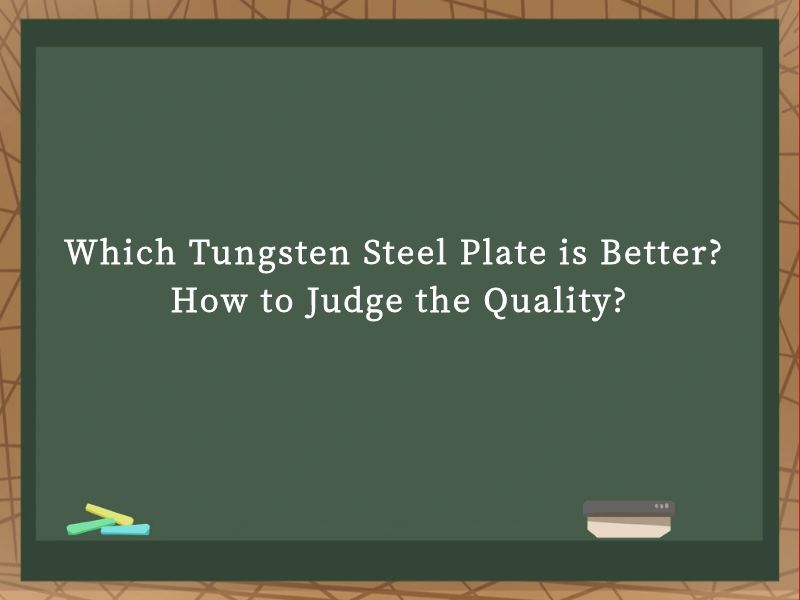JOURNALISM
- NEWS -
|
|
Which Tungsten Steel Plate is Better? How to Judge the QualityWhich Tungsten Steel Plate is Better? How to Judge the Quality?In the realm of industrial materials, tungsten steel plates stand out due to their exceptional hardness, wear resistance, and high-temperature performance. This versatile material finds applications in various sectors, including tooling, mining, and aerospace, where its unique properties make it indispensable. However, with a myriad of tungsten steel plates available in the market, choosing the right one can be a daunting task. To make an informed decision, it is crucial to understand the factors that determine the quality of tungsten steel plates and how to evaluate them effectively.
Understanding Tungsten Steel Plates Tungsten steel, also known as high-speed steel (HSS), is an alloy composed primarily of tungsten, carbon, chromium, vanadium, and molybdenum, among other elements. The addition of tungsten significantly enhances the hardness and wear resistance of the steel, making it suitable for applications requiring high cutting speeds and heavy loads. Tungsten steel plates are typically used in the manufacturing of cutting tools, dies, molds, and other precision components where durability and precision are paramount. Factors Affecting Quality When assessing the quality of tungsten steel plates, several factors come into play. These factors can be broadly categorized into composition, mechanical properties, heat treatment, surface quality, and dimensional accuracy. 1. Composition The alloy composition is the foundation of tungsten steel's performance. A balanced mix of tungsten, carbon, chromium, vanadium, and molybdenum ensures optimal hardness, toughness, and wear resistance. Higher tungsten content generally translates to increased hardness and wear resistance but may compromise toughness. Conversely, a higher carbon content enhances hardness but can reduce machinability. Thus, the specific alloy composition should align with the intended application's requirements. 2. Mechanical Properties Mechanical properties such as hardness, toughness, and tensile strength are critical indicators of quality. Hardness, measured using the Rockwell or Vickers scale, determines the resistance to indentation and wear. Toughness, on the other hand, refers to the ability to absorb energy before fracturing, which is crucial for applications involving impact loads. Tensile strength indicates the maximum stress a material can withstand before breaking, ensuring structural integrity under tension. 3. Heat Treatment Heat treatment processes, including quenching and tempering, significantly influence the microstructure and properties of tungsten steel plates. Proper quenching hardens the steel by forming martensite, a hard and brittle phase. Tempering then relieves internal stresses and improves toughness without compromising too much hardness. The choice of heating temperature, soaking time, and cooling medium during quenching and tempering is crucial and requires precise control to achieve the desired properties. 4. Surface Quality The surface finish of tungsten steel plates is vital for their performance and longevity. A smooth, defect-free surface minimizes friction and wear, enhances tool life, and improves the quality of machined parts. Surface imperfections such as cracks, porosity, and inclusions can weaken the material and reduce its effectiveness. Therefore, visual inspection, along with non-destructive testing methods like ultrasonic inspection, can help identify and reject plates with surface defects. 5. Dimensional Accuracy Dimensional accuracy ensures that tungsten steel plates fit seamlessly into their intended applications. Precision in thickness, flatness, and parallelism is essential for maintaining tool geometry and ensuring part interoperability. Manufacturing processes, including rolling, cutting, and grinding, must be tightly controlled to achieve the specified dimensions within tight tolerances. How to Judge Quality Evaluating the quality of tungsten steel plates involves a combination of visual inspection, material testing, and performance assessment. Here's a step-by-step guide to help you make an informed choice: 1. Visual Inspection Begin by visually inspecting the plates for any signs of defects. Look for cracks, porosity, inclusions, and surface irregularities. A well-manufactured plate should have a smooth, uniform surface with minimal defects. Additionally, check for consistent coloration, as variations can indicate variations in alloy composition or heat treatment. 2. Material Certification Request material certification from the supplier to verify the alloy composition and compliance with relevant standards. Certifications such as those from ASTM, DIN, or ISO provide assurance that the plates meet specific quality and performance criteria. 3. Mechanical Testing Conduct mechanical tests to evaluate hardness, toughness, and tensile strength. Hardness tests can be performed using Rockwell or Vickers indenters, while toughness can be assessed through Charpy or Izod impact tests. Tensile testing provides insights into ultimate tensile strength, yield strength, and elongation at break. 4. Heat Treatment Verification Verify the heat treatment process by examining the microstructure of the steel using optical or electron microscopes. Properly quenched and tempered tungsten steel should exhibit a fine, uniform martensitic structure with minimal retained austenite. 5. Non-Destructive Testing Employ non-destructive testing methods like ultrasonic inspection to detect internal defects such as cracks and porosity. Magnetic particle inspection can also reveal surface and near-surface flaws. 6. Dimensional Verification Measure the plates' dimensions using precision tools like micrometers and calipers to ensure they meet the specified tolerances. Check for flatness and parallelism using suitable gauges or optical flats. 7. Application-Specific Testing Where possible, simulate the intended application conditions to assess the plates' performance. This could involve cutting tests, wear tests, or thermal cycling to evaluate durability and reliability under real-world conditions. Choosing the Right Tungsten Steel Plate Ultimately, the best tungsten steel plate depends on your specific application requirements. Consider the following when making your selection: Operating Conditions: Assess the material's exposure to temperature, pressure, wear, and corrosion to determine the required properties. Cost-Benefit Analysis: Balance the cost of the material with its expected lifespan and performance. Higher-quality plates may have a higher upfront cost but offer longer service life and reduced maintenance. Supplier Reliability: Choose a reputable supplier with a proven track record of delivering quality materials. Look for suppliers with ISO certification and a solid reputation in the industry. Technical Support: Ensure the supplier offers technical support, including material selection advice, processing recommendations, and after-sales service. Selecting the right tungsten steel plate involves a thorough understanding of its composition, mechanical properties, heat treatment, surface quality, and dimensional accuracy. By conducting a comprehensive evaluation using visual inspection, material testing, and application-specific testing, you can ensure that the chosen plate meets your performance requirements and offers the best value for money. Remember, the key to success lies in aligning the material's properties with the application's demands, ensuring both efficiency and reliability in your operations. |


